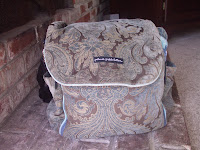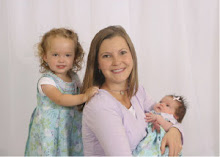 little books, little doll, a few diapers and such –
little books, little doll, a few diapers and such –  no need for this mom of two to carry around a jumbo bag for her wee ones.
no need for this mom of two to carry around a jumbo bag for her wee ones.
Little, or less, is key for Sarah.
 After all, baby gear (furniture, strollers, clothes, toys – you know the list) adds up quick and you could easily spend a small fortune on “stuff” for your little one.
After all, baby gear (furniture, strollers, clothes, toys – you know the list) adds up quick and you could easily spend a small fortune on “stuff” for your little one.Fortunately, Sarah is an expert at getting the most bang for her baby bucks. This crib
 and toddler bed
and toddler bed … free from Craigslist.org. In fact, Sarah’s house is filled with fun accessories for young ones that she’s acquired for next to nothing.
… free from Craigslist.org. In fact, Sarah’s house is filled with fun accessories for young ones that she’s acquired for next to nothing.“I like to find good deals,” Sarah says. “Why spend money when you don’t have to?”
Here are 10 Sarah Saving money tips:
#1 Hand-me-downs: Sarah’s siblings pass on clothes their kids out-grow.
 Since children change sizes so fast, most hand-me-downs are practically new. Plus, anyone who’s actually paid Janie and Jack prices for clothes, and then watches as a “blow-out” or temper tantrum in the dirt destroys the ensemble after less than one use, secretly swears to never buy new again. Be open to inheriting others toys and furniture too, Sarah suggests. This walker
Since children change sizes so fast, most hand-me-downs are practically new. Plus, anyone who’s actually paid Janie and Jack prices for clothes, and then watches as a “blow-out” or temper tantrum in the dirt destroys the ensemble after less than one use, secretly swears to never buy new again. Be open to inheriting others toys and furniture too, Sarah suggests. This walker , rocker
, rocker  , and dresser
, and dresser  were "out-grown" and passed on to Sarah's family.
were "out-grown" and passed on to Sarah's family.#2 Borrow: Halloween costumes generally get worn once
 before they are outgrown from the original owner; so borrow from a sibling, friend, or neighbor. Borrowing works great for large items too;
before they are outgrown from the original owner; so borrow from a sibling, friend, or neighbor. Borrowing works great for large items too;  you don’t have to fork over the $$ and when you are done with it, you don’t have to store it.
you don’t have to fork over the $$ and when you are done with it, you don’t have to store it.  Plus, often you don’t know if your child will like the swing,
Plus, often you don’t know if your child will like the swing,  exersaucer or bouncy seat until after they’ve used it for a while. (The pictured swing, exersaucer and bouncy are things I’ve borrowed or loaned out).
exersaucer or bouncy seat until after they’ve used it for a while. (The pictured swing, exersaucer and bouncy are things I’ve borrowed or loaned out).#3 Clearance rack: Sarah bought these clothes
 for less than $2 at Target on clearance. She says if you sign up for Child’s Place on-line, during your child’s birthday month you get an extra 20% off. By shopping clearance during those months, Sarah says she’s bought brand new shoes, dresses and outfits for 2-3 dollars a pop!
for less than $2 at Target on clearance. She says if you sign up for Child’s Place on-line, during your child’s birthday month you get an extra 20% off. By shopping clearance during those months, Sarah says she’s bought brand new shoes, dresses and outfits for 2-3 dollars a pop!#4 Craigslist.org:
 boppy $4,
boppy $4,  bumbo $10,
bumbo $10,  toy organizer $20. Sarah says she regularly checks out the ‘Baby & Kids’ and ‘Free’ postings.
toy organizer $20. Sarah says she regularly checks out the ‘Baby & Kids’ and ‘Free’ postings.#5 Ebay: brand new stroller
 $80 (with shipping).
$80 (with shipping).#6 Consignment and second-hand-stores: Sarah says she finds
 darling clothes and shoes at a fraction of retail costs. You can also find great toys, like this stroller
darling clothes and shoes at a fraction of retail costs. You can also find great toys, like this stroller for only $4.
for only $4.#7 Coupons: Use them,
 you’ll save money. Sarah also uses frugalisfab.blogspot.com. “Just google ‘free samples’ or ‘coupons’ and you will find a lot of great resources,” Sarah says. She also suggests creating a separate ‘junk’ email account for online registering.
you’ll save money. Sarah also uses frugalisfab.blogspot.com. “Just google ‘free samples’ or ‘coupons’ and you will find a lot of great resources,” Sarah says. She also suggests creating a separate ‘junk’ email account for online registering.#8 Make toys: It's fun. "I think I enjoy making toys more than the kids," Sarah says.
 Use salt dough to make ornaments,
Use salt dough to make ornaments,  create your own holiday decor and
create your own holiday decor and  print out individual pages to color from the Internet rather than buying a whole coloring book.
print out individual pages to color from the Internet rather than buying a whole coloring book.#9 Make 'real' toys: Use things that are 'real' but you no longer need (like old library and grocery store cards)
 to make a play wallet for your child. Chances are, your little one will enjoy the 'real' wallet more than a fake. Old cell phones make great kid phones too.
to make a play wallet for your child. Chances are, your little one will enjoy the 'real' wallet more than a fake. Old cell phones make great kid phones too.#10 Keep your eyes open: Someone else’s trash can be your treasure. A neighbor put this toy
 out with the garbage. Sarah took it, cleaned it up and added batteries. “It works great,” she says. Another ‘dumpster-dive’ treasure:
out with the garbage. Sarah took it, cleaned it up and added batteries. “It works great,” she says. Another ‘dumpster-dive’ treasure:  this outdoor sandbox.
this outdoor sandbox.Final Note:
Sarah cautions that not all good deals are worth your time and money; know what you need to purchase and aggressively find the best deal. “If it’s something we don’t need,” Sarah says, “no matter how cheap it is, it’s not a good deal.”































